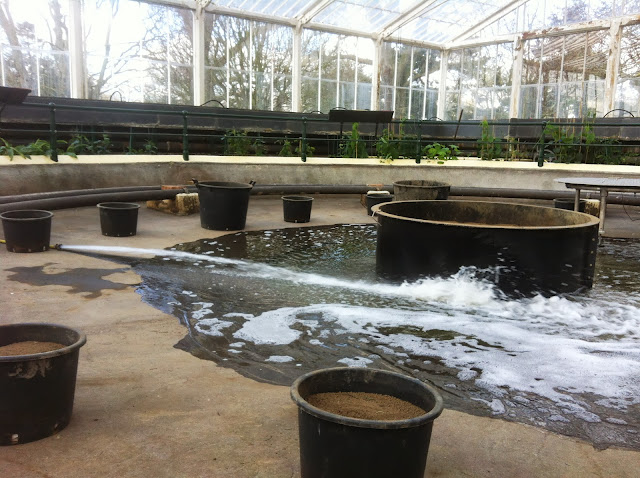
The Waterlily House is one of Kew’s smallest glasshouses,
but is easily one of the busiest attractions! Here is housed a giant waterlily,
Victoria cruziana, and countless other tropical gems and floral delights. The
house was built in 1852 specifically to house the larger and more famous species,
Victoria amazonica, using the same iron work detail provided by Irishman
Richard Turner who built the nearby Palm House. Unfortunately the V. amazonica
was never happy here and is now planted in the Princess of Wales Conservatory,
but the Santa Cruz waterlily flourishes and the lipped-rimmed leaf pads
add greatly to the display in this small house. Every autumn the house is
completely taken apart and removed, with plants, soil, water and even the fish shipped
out! The house remains empty during the bleak winter months, and then in spring
is restocked and replanted with plants and fish for the summer display. I was
luckily enough to help out with the replanting this year and below follows some
of the progress and development in the house from reopening in February to the
June view yesterday afternoon!
 |
| Sign reads, “Where are the waterlilies? On a winter
break!” That break is now over as spring is here |
 |
| The new compost arrives, the first of many large bags |
 |
| All of the raised beds are filled by hand! |
 |
| The final wheelbarrow is filled and then the beds are
full |
 |
| The Tree Gang arrive from the Arboretum to help raise
the Nepenthe baskets above the pond |
 |
| With all of the waterlily planters in place, it is
time to fill the pond! |
 |
| The first planting is the structural foliage specimens
such as Calathea and Alocasia |
 |
| With the waterlilies planted the house opens to the
public! The Spanish galleon masthead was a temporary feature for the Easter
chocolate festival |
 |
| Three weeks later the pond is almost filling up! |
 |
| A distinguished visitor makes a graceful exit |
 |
| Waterlily stems have these hollow sections contained within
them, providing the buoyancy required for the foliage and flowers to rest on
the water's surface |
 |
| A netting of Passiflora provides the necessary shading
to satisfy much of the floral bedding display, which prefer dappled-light
conditions and can scorch in full sun |
 |
| The incredible glory of Passiflora alata! |
 |
| Many smaller hybrids also inhabit the pond; this is Nymphaea
carpentaria x violaceae, a cross created at Kew by my old boss Carlos Magdalena |
 |
| Waterlily foliage is armoured with fierce (painful)
spines which deter herbivores and help support the leaf ribs! |
 |
| The Victoria flowers are, inevitably, both large and glorious! |
 |
| Another of Carlos' Nymphaea hybrids, and as yet unnamed |
 |
| Close up in the pond, with more detail of the leaf rim
and protective spines! |
 |
| June view of this wonderful tropical house |

